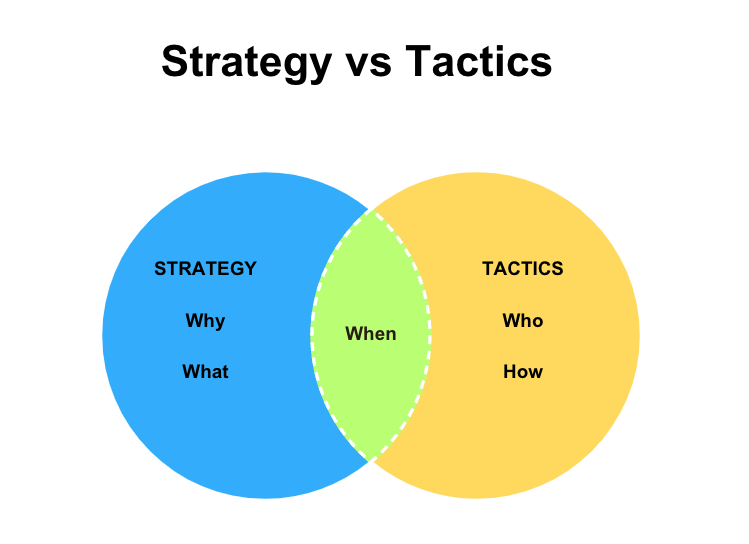14 min
Strategy vs Tactical Marketing
By David Lee

First, let’s get the obvious out of the way: you need good strategy and tactics to win the marketing game of attracting good prospects, demonstrating that your company can solve their problems, and prove that you are easy to work with.
A lot of times people describe strategic marketing as the big picture or the long term business objectives and tactics are the short term plan and actions needed to achieve a specific goal.
It's a good general overview, but I find this definition is a bit vague and all too often people still get confused, especially when it comes to marketing tactics vs marketing strategy.So let’s start with the easier of the two: Tactics.
What is marketing tactics
Marketing tactics are the individual steps and actions that are used to achieve a specific goal.
Common marketing initiatives include:
-
Monthly Newsletters
-
Email nurturing campaigns
-
Educational Articles
-
Educational Videos
-
Trade shows
-
Sell sheets
-
Catalogs / brochures
-
Coupons and/or discounts
-
Organic social media posts
-
Paid Social media advertising
-
Technical SEO
-
Networking events
-
Inbound marketing
-
Cold calling
-
Podcasts
-
Account Based Marketing
-
Website design
-
Website incremental improvements
-
Landing Pages
Depending on the marketing technique, each of these activities is designed to generate targeted traffic to your website or once they reach your website, increase how engaged the visitors are with your content and help engage qualified visitors and move them through the sales process.
The Three Questions that Tactics answer:
-
When will this task be executed?
-
Who will execute the task?
-
How will the task be performed?
Examples of a Marketing Channel: monthly newsletter:
-
WHEN: The Monthly newsletter will be sent out on the 15th of every month.
-
WHO: ACME marketing agency is responsible for managing and executing the Monthly Newsletter.
-
HOW: ACME will create the newsletter in Hubspot and link to specific and relevant articles on the website
So tactical marketing is “short term” where the timescale is measured in days and each activity is designed to achieve a specific result.
Marketing Strategy is a bit more complicated.
What is Strategy
Before we get into Marketing Strategy, let’s first figure out what Strategy means.
A lot of people confuse strategy with having a plan. They are not the same.
A plan is the output of the strategy process, but, at the heart of things:
Strategy is about making decisions.
- David Lee
Let me give you an example from one of the things I like to do: playing video games.
Two of my all time favorite games are strategy games: Star Craft II (Real Time Strategy) and Civilization (Turn based Strategy).
The primary skillset of these games is how good are you at making decisions based on information at hand?
-
You need to understand the strength, weaknesses, capabilities, purpose and cost of each unit.
-
You need information on what your opponent is doing. This is often obscured by the “fog of war”.
-
You need to manage your limited resources (gold, minerals, gas, lumber, etc) and then using your knowledge of the units and what is going on the battlefield, make decisions around which units to build and when.
Strategy is about making choices
This is not me in an ivory tower or simplifying strategy to the types of video games I like. Here is how Harvard Business Review defines strategy:
“Strategy is making trade-offs in competing.
The essence of strategy is choosing what not to do.”
So if you take these gaming concepts and translate it to marketing, you are essentially doing the same thing.
Marketing Strategy is about making data driven decisions
Marketing strategy covers the same elements as strategy.
-
You need to understand the strengths, weaknesses, capabilities, purpose and cost of each marketing activity. (notice, that you do not need to know how these tactics are done)
-
You need information on how your website and customer acquisition channels are performing. You also need to research and analyze the competition and market so you can clear “the fog of war”.
-
You need to manage limited resources (money), know what is going on in the industry and your competition, understand the capabilities and cost of your marketing agency / internal team and make decisions around what tactics to deploy and when.
What is Marketing Strategy
Marketing Strategy is the process of how you make decisions on which marketing tactics should be used. The output of an overall marketing strategy is a marketing plan that outlines what tactics need to be implemented and when.
The first step in the strategic marketing process is to get the critical pieces of information so you can start making data driven decisions and informed choices.
How to create a marketing strategy:
-
Document Business Goals
-
Document Ideal Customers
-
Identify your high value customer acquisition channels
-
Evaluate the performance of your website
-
Manage the Marketing Budget
Document Business Goals
Usually this is the easiest data to collect because just about every company has an annual planning process. The business goals are usually defined as sales, revenue, or number of customers.
The key exercise here is to look at these goals and formulate ideas and hypotheses what marketing goals needs to be set to achieve the business goals.
Why Marketing fails to deliver results
The biggest reason why marketing fails: they are looking at the wrong metrics.
It is tempting to start creating a detailed laundry list of marketing goals, but these are usually too granular to use at the strategic level.
When it comes to creating the strategic marketing plan, the first thing you need to decide on is which problem do you need to solve:
-
You have a traffic problem: you are not getting enough qualified visitors to the website
-
You have a conversion / engagement problem: once visitors get to your website, they are not taking action and they are not “sticky” visitors.
Identifying the primary problem first, determines what needs to be done in order for marketing to help the company achieve its business goals.
Document your Ideal Customers
Most of the time, the buyer personas are actually well known by the sales and customer support teams because they are the ones who have face to face contact with your customers.
But that information is not usually well documented, so the marketing team and external agencies are left creating traffic campaigns without a clear understanding of the target audience.
The key thing to remember here is that understanding the buyer persona is more than just knowing their demographics such as age, education, company and title.
It means understanding the psychological problems they are trying to solve such as:
-
What happens to their career, their bonus or standing within the company if they fail or succeed?
-
Why is this so important to them right now to solve?
-
Why are they thinking of your company as a solution?
By having a deep understanding of your target audience, the tactical marketing team can build the messaging to persuade them that your company is the perfect guide to help them solve their problems.
Identify your high value customer acquisition channels
Probably better known as “marketing” these are the activities that drive traffic to your website. There are a lot of full service or specialized marketing agencies who provide services such as:
-
Email marketing
-
Content marketing (Content SEO)
-
Paid Advertising (Google, Yahoo, Bing)
-
Social Media - Organic
-
Social Media - Paid
For strategy, it's not necessary to understand or manage the specific tasks. It’s more important to manage the costs and the results. For analyzing traffic results, I recommend the following:
KPI's for analyzing traffic generation performance:
-
Sessions
-
Engagement Rate
-
Average Engagement Time
You will notice that one metric I did not include is conversion rate by channel. In the past, I was pretty passionate about tracking every conversion by traffic source. However, as Gartner pointed out:
"Customers today are trying to accomplish what are
often non sequential steps to complete a purchase
and that has completely undermined
the traditional model of linear deal progression.”
In other words, because customers are looking to find solutions from companies that:
-
Understand their problem
-
Have the experience and expertise to solve their problems
-
Demonstrate that they are easy to work with
By analyzing the performance of each customer acquisition channel, you can start to make funding and resource allocation decisions to:
-
Double down on the tactics that are producing results
-
Reduce spend on the tactics that are generating suboptimal results
-
Invest in other channels to explore new opportunities
Evaluate your Website Performance
From a strategic point of view, your website is the keystone of the entire marketing strategy and as I explained in my article on why you need a website:
-
People are afraid of choosing the wrong product or service provider
-
To reduce this fear, people research before they buy
-
People research online and ultimately come to your website
Because people research before they buy, your website is the primary method for you to prove that you:
-
You understand their problems
-
Have the expertise and experience to solve their problems
-
You and your company are easy to work with.
If it sounds like I am repeating myself, I am.
All too often people tell me that the reason why they need a website is to generate leads. That is certainly a solid reason for your company to invest in a website.
But I can assure you that getting on your email list, subscribing to your blog, or being put into your sales funnel is NOT the reason why people visit your website.
It's time that marketing to stop talking about what is so great their company and start helping people solve their problems.
The metrics to measure your website performance is similar to traffic:
Website KPI's
-
Engagement Rate
-
Average Engagement Time
Except instead of looking at these numbers by traffic source, you look at them on an individual page level.
There are two other website “metrics” are:
-
Conversion Rate - Overall, on the site, how is the conversion rate for leads, customer support or general questions. You need to not just measure form conversions, but also track phone calls, chats and emails.
-
Heat Map - This is not really metric, but more of a tool (such as Hotjar or CrazyEgg) that allows you to visually understand how visitors are navigating (clicks, mouse movements and page scroll) the critical pages of your website.
Manage the Marketing Budget
Out of all the data needed to make informed decisions about resource allocation, getting the annual marketing budget is the most difficult.
Without a robust FP&A (Financial Planning & Analysis) process to guide them, most companies struggle with a true marketing budget. Instead, their spending hinges on what's left in the bank or how the year is unfolding financially.
Indeed, for most companies, marketing is the first expense to be cut. But as McKinsey points out
During tough times, marketing is often the first to be trimmed,
but that’s a shortsighted approach.
Instead, companies can invest in marketing as
a key to long-term growth.
Without a Marketing Budget, you cannot have a Marketing Strategy.
Remember that strategy is making informed decisions on where to allocate resources.
If you don’t adopt an investment mindset and have an annual or at least a quarterly marketing budget, then it's nearly impossible to make decisions on how to allocate funds with a long term vision.
Instead, decisions on what tactics will be funded will be based on the funds in the bank.
How much should you spend on marketing?
While there is no fast or hard rule, as a general rule, you should be spending about 10% of your gross revenue on marketing. For more information, you can read this article to compare your marketing spend vs industry.
How to create a marketing strategy
Creating your marketing strategy is making a choice on which tactics need to be implemented for a given time frame: I prefer to manage on a quarterly basis so you can measure trends and not month to month variances.
Five steps to creating a marketing strategy
When I first started out in marketing, I had a custom solution for every client that hired me, because let's face it - at that time I didn't know what I didn't know, but could figure things out.
Now, I come in with this process that has proven to be effective in getting better results, faster.
-
Gather the five data points outlined above.
-
Work with the sales team, support staff and external agencies to come up with a list of possible marketing tactics that will help move the revenue needed.
-
Determine the business impact and cost/complexity of each tactic and prioritize the activities along the lines of highest impact and lowest cost.
-
Get the executives on board so that the SOW with the external vendors are signed.
-
Provide program management support to external vendors and manage results.
SUMMARY
The differences between strategy and tactics can be answered by examining these five questions and where they fall.
- Why do we need to do something?
- What needs to be done?
- When should it be done?
- Who should do it?
- How should it be done?

To build an effective marketing strategy you need data on how your website and marketing tactics are performing, what are the costs to implement the tactics, and make a decision on which activities can be funded based on the marketing budget.
Need help?
If this sounds like you need a specific skill set to do strategic planning, you are right.
You don't need a tactician or an expert in a specific marketing discipline.
Usually a Chief Marketing Office (CMO) is the resources you need to make decisions on what the overall marketing plan (Strategy and Tactics) needs to be to meet the company's business goals.
However, many companies can't afford or don't need a full time CMO.
Learn more about how a Fractional CMOcan help you get better results, faster.

Leveraging 20+ years of experience with Fortune 500 companies including Toyota, Beckman Coulter, and Deloitte, I craft data-driven website and content strategies to help companies compete and win in the digital age. Explore my insight articles to learn what works and how to craft winning strategies and tactics to move the revenue needle for your company.